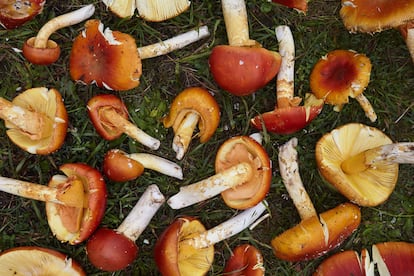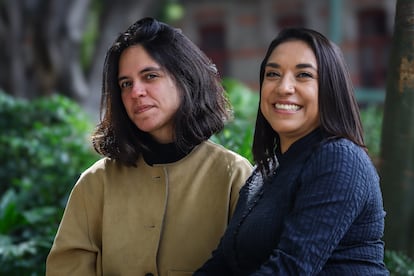With the arrival of the Spanish conquistadors to Mexico, many prohibitions were also issued. One of them was the use of Teonanactla sacred mushroom for indigenous peoples. This endemic species — whose translation into Spanish is meat of god — “was consumed in sacred ceremonies to contact the gods and make requests,” explains ethnomycologist Amaranta Ramírez Terrazo, an expert in that science who studies the relationship between fungi and cultures. . Those bearded men from strange lands considered those mushrooms to be hallucinatory drugs and banned their consumption. Ramírez and the linguist Laura Linares Colmenares have created the Gastronomic Dictionary of Mexican Mushrooms (Elefanta editorial), in which they explore the history of the so-called fungi kingdom in Mexico and its relationship with the inhabitants of this country. The work is part of the publishing industry’s passion for mushrooms, which this fall fills bookstores with works related to these species, their use in cooking and their benefits for food.
He Teonanactl It was related to meat due to its flavor and texture and, together with other species of fungi, was part of daily life before the colony. The ancient settlers of what is now Mexico saw in that kingdom a succulent gastronomic alternative, which was lost as new customs were imposed in what would later be called New Spain. “There was a racist and classist connotation that mushrooms are poor people’s food and for haute cuisine it was an ingredient that was not of interest,” explains Linares, a specialist in food terminology. Now, however, there is a boom related to the use of mushrooms in gastronomy, but these authors complain that the preparation methods are still very European, mainly influenced by French cuisine. The expert tells the anecdote of a trip that the Mexican politician Melchor Ocampo made to Paris, who was surprised by the consumption of mushrooms in the restaurants of the City of Light and thought that perhaps those species that he viewed with distrust were not so bad “At that moment the issue of fungi comes back on the table,” says Linares.
The authors have investigated the traditions of the people of Mexico to propose new ways of preparing mushrooms. Its dictionary contains not only the history of these species and their importance for life, but also has recipes based on local traditions to prepare different dishes, such as chalupitas with mushrooms, pink mushrooms or maguey mushroom, morel in green sauce , cornets with chicken or pasta with slimy belly sauce. And the names in the dictionary deserve a separate mention. “We have used the terms that people use in their connection with the fungus so that they can be used in a general way. They are more beautiful, poetic names than scientific ones; a variety of names that connect with a positive perception of mushrooms,” explains Linares. The dictionary has 30 names such as sanjuanero mushroom, bird’s paws, ahuevado, Juan Diego, deer’s eye, pedito, trumpet of death or gachupín, which is the word that was used to refer disparagingly to the Spanish.
“We cannot talk about fungi if we do not resort to all ancestral knowledge. This is what is rich about the dictionary: the knowledge of the communities, the journey with the people in search of mushrooms, because they were present in the daily activities of the life of the native peoples in Mexico. They were present in their food, in their medicine, in their worldview, even in their religious and cultural practices,” says Ramírez. “The native peoples learned to eat certain species and we recovered preparation techniques, because some can be toxic. We can take into account criteria such as color change due to abuse. There is a fungus that permeates a lot within the urban environment and if you boil it with garlic, the garlic turns black. Training from mythology, anthropology, linguistics and gastronomy is important to know how to consume them,” he adds. Mushrooms are also excellent species for consumption, because “they have vitamins, proteins, a lot of fiber and are low in bad fats,” says the expert. Ramírez explains that these species have cell walls that are the key that makes them different from plants and animals. These cells “have components called beta-glucans and instead of producing a reserve substance such as cholesterol, they produce ergosterol, which helps strengthen the immune system. Within the original worldview, cultures propose that mushrooms provide medicine just by eating them.”
Other autumnal works about the so-called fungi kingdom are Fungal status (Novo), a book by Nanae Watabe, edited by María Álvarez and with photographs by Peter Norman. The publisher explains that the work was born from the “special love” of Watabe—daughter of a Japanese father and Mexican mother—for wild mushrooms. The author, who has a master’s degree from the University of Gastronomic Sciences in Italy, regularly attends forest tours accompanied by chefs. “It is a supplier of the best restaurants in Mexico City, such as Hugo, Quintonil, Anónimo, Meroma, among others, and tries to exalt Mexico through the fungi kingdom,” says the publisher. This book also visually explains the relationship of mushrooms with the communities of the State of Mexico, Puebla and Oaxaca, the collection season, the local varieties and how they are sold in the markets, because, the author highlights, it is in those places traditional trade where you can find the best species.

Watabe, Linares and Ramírez emphasize the importance of forests for the survival of fungi. “There are no forests without mushrooms,” says Watabe in his book. “The indiscriminate felling of forests and poorly focused reforestation threaten them,” agrees Ramírez. “If they reforest with non-native species, they can cause monoculture in the forest and the diversity of fungi decreases,” he adds. “Where there is a territory with mushrooms there is a living land for cultivation,” says Laura Linares.
The works on mushrooms not only delve into their gastronomic potential. The Mexican essayist Naief Yehya has published The mushroom planet (Editorial Anagrama) framed in the hallucinogenic power of these species. In the introduction to the work, Yehya explains that in the early nineties of the last century he became interested in the changes that the Internet imposed on the world and was struck by “the abundant use of psychotropics, especially psychedelics, among engineers, developers, creators and programmers who created and marked the Internet industry. “Much of the visions and achievements of cyberculture had been inspired by hallucinogens,” says the author, who wanted to recover that history in his work, a book that covers everything from how “our hominid ancestors in the Stone Age discovered hallucinogenic mushrooms and that reaches Silicon Valley, passing through caverns, cathedrals, universities and corporations.” It is, in short, a literature that is reconciled with that kingdom that can fill kitchens with smells, seduce the palates or stimulate the senses.


